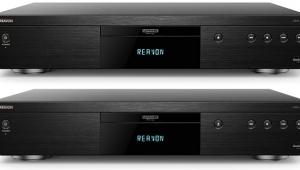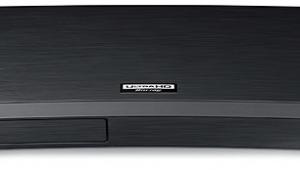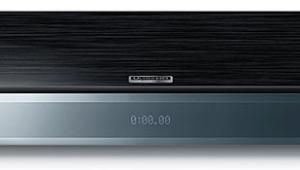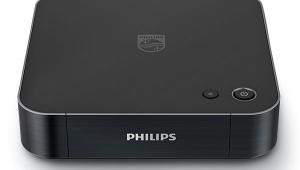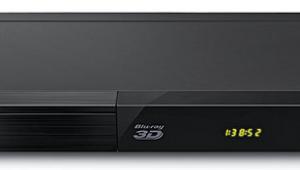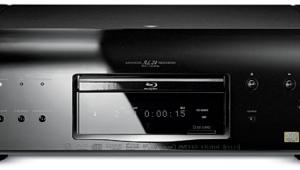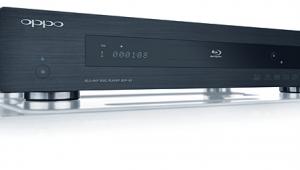I would prefer if Magnetar sold a simple transport version of this player with only HDMI out. I fail to see the reason in 2024 for analog audio out of a player, which prevents the effective use of room correction/EQ or using a subwoofer. Removing the high-performance DAC section of this would lower the rather high price.
Magnetar UDP800 Ultra HD Blu-ray Disc Player Review
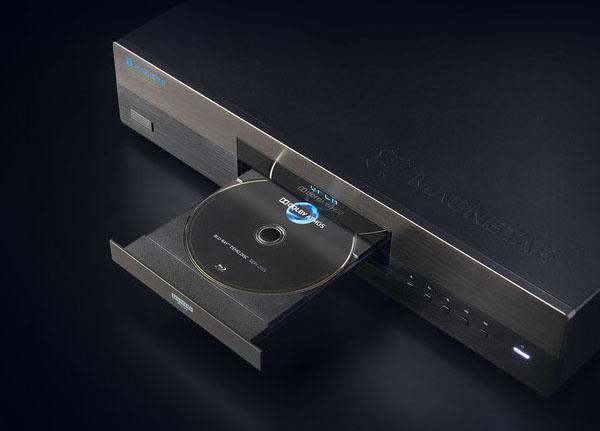
AT A GLANCE
Plus
Fantastic build quality
Universal disc compatibility
Analog XLR audio output
Minus
No Wi-Fi or onboard streaming apps
Horrible remote
THE VERDICT
The player's build quality is top-notch, but there are a few quirks that need to be addressed.
Though the famous Samuel Clemens (Mark Twain) quote, “The reports of my death are greatly exaggerated,” has been twisted over time from the original quote, “The report of my death was an exaggeration,” both very much apply to the state of physical media today. Physical media is far from dead even though Best Buy has decided to stop selling DVDs, Blu-ray, and 4K Ultra HD Blu-ray discs both in stores and online.
The only people cheering Best Buy’s decision are the stockholders of Amazon, Walmart, Target, and other smaller online marketplaces who will now increase their market share of physical media.
Regardless, physical media isn’t going away anytime soon. Just look at the release of the Oscar-nominated Oppenheimer—it sold out within days upon its release in December 2023 and the studio had to issue a press release saying that more physical copies were being produced and would be in stores as quickly as possible. Was this a case of the bean counters underestimating demand or of consumers wanting the best presentation possible for the Best Picture of 2023. Regardless, NBC/Universal was thrilled with the response to the movie, and their new collaboration with Christopher Nolan is off to a resounding start.

As much as I personally love physical media—and my collection of over 2,000 titles will attest to that—I can’t say that I don’t stream a good quantity of my entertainment these days. While the picture quality has come a long way due to advanced compression technologies, the audio still leaves a lot to be desired with the low-bitrate Dolby Digital Plus. Until the streaming companies can figure out a way to give us uncompressed Dolby Digital Atmos and DTS:X, those who want the absolute best quality are going to stick with physical discs to consume the best that Hollywood has to offer, so the need for a top-quality Ultra HD Blu-ray player isn’t going away anytime soon. For years, Oppo was my brand of choice.
Not only were its players built well, but the company offered arguably the best service of any A/V company on the planet. Sadly, in 2018 they discontinued all production of their UHD Blu-ray players and, while the secondary market is loaded with used players (at three-times what the players sold for new), they weren’t the only brand to drop out of the space. Shortly after Oppo’s decision, Samsung and Pioneer followed suit, leaving consumers with fewer choices.
Thankfully, the market has a funny way of working things out. Panasonic, Sony, and LG stayed in the Blu-ray game and have since been joined by new brands willing to pick up the slack. One such brand is Magnetar, a company based out of China with distribution in Europe from Archisoft, the company behind the Reavon brand and its U.S. subsidiary, Let’s Get Physical Distribution.
The Magnetar UDP800 is a universal disc player that plays not only UHD and HD Blu-ray but DVD, CD, SACD, DVD-Audio, and even Kodak Picture CD. Additionally, the player supports Dolby Vision and HDR10+ high dynamic range (HDR) and is equipped to play media files encoded in H.265 and H.264 . Finally, it can also play music and movie files from your home network or a connected external hard drive (up to 16 terabytes).
Build Quality
When the Magnetar first arrived from FedEx, I was shocked at how similar the packaging was to Oppo’s—double boxed with the player wrapped in a high-quality bag and firmly secured with a Styrofoam top and bottom. Unlike the Oppo, the remote and power cable don’t come in their own box, but they are securely packed under the player in precise foam cutouts. Also included in the box is a well-written user manual that is already outdated due to new functionality that has been added via firmware, so expect to see some slight variations to the menus versus what’s shown in print.

The build quality of the UDP800 is top-notch with a large power transformer, double-layer 1.6mm chassis, and 3mm-thick steel under-plate, which helps explain its 17.6 pounds of heft. This isn’t a dainty player by any stretch. Why does weight matter? It reduces vibration and the noise it generates when a disc is playing; it can be quite distracting to hear a player during quiet film passages. Furthermore, internal components such as the tray mechanism and power supply are independently shielded to reduce external magnetic fields. For $1,599, you expect solid construction and that’s what you get with this player.
The two-toned brushed aluminum front panel is very attractive (if you find A/V components attractive—I do, so please don’t judge). The disc drive, front and center, is whisper quiet and as sturdy as they come. Actually, it’s the sturdiest disc tray I’ve seen in any disc player commercially released over the past 25-plus years. Above the disc tray is an easy-to-read LCD display window with a USB input to the left and Eject, Play/Pause, Stop, Previous, Next, and Power buttons to the right.
One item of note, this is the first player I’ve ever used that can’t be turned on by hitting the Eject button. To get the tray to open, you must first hit the Power button and then wait about 3 seconds to open it. I’ve grown used to this, but it’s something my wife has complained about more than once. What’s strange is you can boot up the player by hitting the Eject button on the remote. When I asked the company if this is something that could be addressed in firmware, they informed me that it could not be changed, so it remains a minor annoyance.
The rear panel includes an Ethernet/LAN port, dual HDMI outputs (one Audio only), a USB v3.0 port, two digital audio outputs (one coax, one optical), an RS-232C port, and two sets of gold-plated analog stereo outputs, one of which is balanced XLR. Some may balk at having only stereo outputs in lieu of a full suite of 7.1 outputs but, frankly, it avoids rack clutter and I like the convenience HDMI offers. In listening tests, I was unable to detect any difference between the HDMI and analog connections.
One feature missing from the player is Wi-Fi, so you’ll need to have Ethernet wired to your rack to use the networking features of the player. If you’re looking for an all-in-one box with apps from Netflix, Amazon, Apple+, and other major streaming providers, this isn’t the player for you. Frankly, the standalone streaming boxes are the way to go anyway.

Internally, the UDP800 boasts a pair of 32-bit, 192-kHz Burr-Brown PCM 1795 DACs to handle the two-channel digital-to-analog conversion along with a MUSES8920 OP-AMP to ensure high-quality sound. A Media Tek MT8581 SOC (system-on-chip) is employed for 4K UHD playback and upscaling with support for Dolby Atmos and DTS:X surround sound. Yes, this player does it all.
User Interface
The player comes with a backlit wand-style remote that I’m not a big fan of. First off, it’s cluttered with over 48 different buttons and, while it does light up, you need to hit the “light” button, which isn’t exactly intuitively placed on the side of the remote. Granted, I’m not a fan of most stock remotes, which is why I use a URC MX-990 in my theater. For those looking for a Magnetar app to control the player with your phone or tablet, you’re out of luck—none is offered.

At one point, a lot of players offered an “auto setup” program that kicked in the moment you turned the player on, but I can’t remember the last time I saw that. Regardless, setting up the UDP800 is quite simple, and those familiar with Oppo players will find the menu system very familiar. The Main Menu is broken down into six sections: Disc, Photo, Music, Video, Network, and Setting. Each section is so intuitive that I was able to navigate through them without having to crack open the owner’s manual.
The Settings tab has the usual array of functions such as Display, Audio, Playback, Network, Security, Languages, and Option. Owners of outboard scalers will be happy to learn that the player has a “Native” output setting to allow your scaler to process the video image. Normally, this would be my choice, with the output going to my reference JVC DLA-NZ8 projector, but my wife still watches the occasional DVD and the projector can’t process a 480i image. I ended up using the 4K2K output for the majority of my testing and found the player to be excellent at upscaling 1080p Blu-ray discs in addition to passing 4K UHD images natively at 2160p.
Real-World Performance
When Oppo stopped manufacturing new players I was worried about long-term support and decided to replace the BDP-203 I had been using with a Panasonic DP-UB820 to ensure I could keep the player up to date with the latest firmware. Unfortunately, I jumped the gun and have since learned that Oppo has continued to support the player all these years later.
While the Panasonic has served me well, the build quality pales in comparison to the Magnetar. It’s not even close. The Panasonic’s disc tray is so flimsy that I worry about it snapping off if I’m not careful when placing a disc in it. Furthermore, the Panasonic doesn’t play MKV files with full audio resolution–something the Magnetar offers. I have hundreds of movie clips saved for demos that are a breeze to access either through my home network or via an attached USB drive. This is one area where the Magnetar shines.
I rarely listen to music saved on my home network because I’ve gotten spoiled listening to high-resolution tracks from Amazon Music, which is a great deal at less than $10 per month. But that didn’t stop me from streaming some FLAC files I still have on my Synology server. As expected, the files loaded and played with ease. My wife particularly liked being able to use the player to go through old photos stored on our network. Even though she’s not the most technologically-minded person, she had no problem figuring out how to work her way through the menu system.
Since the player is, first and foremost, a disc player, that’s what I spent most of my time using and testing. Other than a few UI quirks, the UDP800 played back every disc flawlessly. Since becoming empty nesters, our evening ritual includes watching an episode of an old classic sitcom. Our current show of choice is the 1960s hit Hogan’s Heroes, which I purchased on Blu-ray. While the show is formulaic, the writing is pretty good, and we enjoy the cast of characters.
The Blu-ray transfer isn’t anything to write home about, given the age of the show, but it certainly looks better than what you’d see on cable or satellite, and better yet, there are no commercials to deal with. I’ve had the player for a couple of months, and we’ve gone through three seasons of the show and playback has been spectacular with accurate color reproduction and speedy navigation.
I wouldn’t consider myself a huge fan of The Hunger Games franchise, but I like entertaining movies, and when The Hunger Games: The Ballad of Songbirds & Snakes came in for review, I definitely looked forward to giving it a spin. While the movie is middling, the 4K presentation is about as good as it gets. It sports a 4K DI (digital intermediate) and this certainly shows throughout the film. The sepia-toned color grading is to die for, and the detail in the picture is mesmerizing down to the most minute details in clothing and facial pores. Not to be outshined, the Dolby Atmos soundtrack is full of demo-sequences. Thankfully, the Magnetar loads the disc in less than 30 seconds and its well-built disc mechanism never made a peep—everything you’d expect from a top-notch player.
Turning to music, I had to dig through my attic to find some shiny discs to play. After I sold my Oppo, I moved away from discs and went to full-time streaming for music, but I realize there are still a lot of people with large music collections. Thankfully, I kept a handful of SACDs and DVD-Audio discs just in case I ever needed them again.
I dusted off a copy of the Footloose soundtrack on SACD to relive some of my teenage angst from the 1980s. The title track was the main reason I purchased this disc over 15 years ago, and the Magnetar does it justice. I let the player handle the decoding and sent analog audio to my Trinnov Altitude16 processor. The presentation was impressive. The song has a lot of energy and, yes, it comes with a good dose of cheese, but once you hear it, you can’t get it out of your brain, so it’s no wonder the song went to No. 1 on the Billboard charts. Kenny Loggins’ voice is front and center and the track dates itself with an overreliance on synthesizers and drum machines but, hey, that was the sound of the 80s!

The Magnetar doesn’t color the music one bit and its analog output delivered a nice spread between the synthesized instruments and the song’s memorable lyrics. In one listening test, I pitted the analog output against the HDMI output to see if I could hear a difference but found that I would be hard-pressed to pick one over the other in a blind test. Personally, I prefer HDMI for its ability to minimize rack clutter, but if you prefer a gaggle of cables, more power to you. I sampled various other DVD-Audio discs as well as Redbook CDs and had no complaints.
I briefly mentioned the issues I had with operating the player via its front-panel controls, but there are a few other minor quirks that need to be mentioned as well. For starters, after you put a disc in the tray, you have to hit the Eject button to close the tray, even when using the remote. In every other player I’ve used, hitting the Play button usually closes the tray and starts playback. Not so here.
Another minor annoyance is when you hit the Display button, it tells you how much time has elapsed in the movie, instead of how much time is remaining. Thankfully, Magnetar has acknowledged this problem and plans to address it in a firmware update (which may have already occurred by the time you read this).
Speaking of updates, this is another area where the UDP800 shines. Since I’ve been using the player, Magnetar has issued multiple firmware updates to fix potential disc compatibility issues and add new features. One lets you export and import your preferred player settings, which is very handy, since the player reverts to its factory setting after every firmware update. I highly recommend backing up your settings once you’ve settled on what works best in your system.
Summing it up
Since Oppo stopped making Blu-ray players, I’ve been hunting for a 4K UHD player that equals or surpasses the build quality of the BDP-203. It’s taken me six years, but my search has ended. The Magnetar UDP800 has everything a disc lover desires: sturdy build quality, a whisper-quiet transport, and the ability to play virtually every 4.75” disc known to man (except HD DVD). Throw in the fact that the company keeps the player in tip-top shape with frequent firmware updates and it’s easy to see why it is worthy of receiving our Top Pick designation.
SPECS
BD-Live: Yes
3D: Yes
Audio Decoding: Dolby, Dolby Atmos, Dolby TrueHD, Dolby Digital Plus. DTS; DTS:X, DTS-HD Master Audio, DTS-HD High Resolution
HDMI Video Resolutions: 4Kx2K, 1080p/24, 1080p, 1080i, 720p, 576p, 576i, 480p, 480i
Compatible Playback Formats: UHD Blu-ray, Blu-ray, Blu-ray 3D, DVD-Video, DVD-Audio, AVCHD, SACD, CD, Kodak Picture CD, CD-R/RW, DVD±R/RW, DVD±R DL, BD-R/RE
Dimensions (W x H x D, Inches): 17 x 3.5 x 12
Weight (pounds): 17.6
Price: $1,599
Video Outputs: HDMI x 2 (main + audio only)
Audio Outputs: Coaxial digital (1), optical digital (1), stereo analog (1), stereo analog XLR (1)
Additional: Ethernet, (1), USB (2), RS-232
- Log in or register to post comments


The analog outputs are 100% necessary for anyone using it as a decent SACD/CD player. Most Integrated amplifiers don't have HDMI input and even less can accept DSD over HDMI. You need to use the internal DAC to process the DSD and then output analog to your amplifier.

Will the Magnetar convert SACD to hires multichannel PCM over hdmi if the receiver doesn’t support DSD? Oppo does this. Or am I stuck with 2 channel analog if my receiver doesn’t do DSD?

I have a sister player from the Archisoft Group - the Reavon UB200. The Reavon boasts 2-channel and multi-channel analog playback, and can spin Super Audio Compact Disks. Different Burr-Brown DACs are used for 2-channel and multi-channel playback.
The gotcha is that all SACD channels are reduced to CD quality by the DACs so the sound quality is noticeably below expectation. I am fortunate that I have a capable AV pre-processor (Marantz 8800) which has eight very good Japanese DACs (on a par with Oppo). It accepts DSD over HDMI. I therefore never use those (100% necessary?) expensive analog capabilities in the player, and everything is output via HDMI.
Most of my listening is to multi-channel SACD, but I am also blown away by the surround-sound recordings from Norwegian label 2L and some Atmos re-releases like Dark Side of the Moon.
The Reavon has additional problems when attempting to output analog from SACD, which is incorrectly documented in the manual. Most times, what is output is full volume noise. The Reavon is an expensive transport.
Beware

I have an Oppo 203 and NAD t778 receiver. It doesn’t support DSD, but the Oppo sends multichannel PCM over hdmi at the hires rate. Does the Reavon do this too? Or does your comment about converting DSD to cd quality only apply to analog output?

My comment on the Reavon converting DSD to CD quality only applies to analog output. It happily sends DSD over HDMI, but I cannot remember if it can also convert DSD to multi-channel PCM. I will try to check this out next time I am home.

Does the Magnatar allow external subtitles from USB like the Oppo did?
This feature was godsend for the Oppo- If you bought a disc that had no english subs, you could simply download the subs to a USB and play the subs with the disc.

The oppo added 10 second replay after it was released, although you had to hit the a-b button twice quickly vs a dedicated remote button.
Does the magnetar or reavon provide this?

The Magnetar UDP800 offers impressive video and audio quality, making it perfect for home theater enthusiasts. Its 4K HDR support and smooth performance make it worth the investment. I recommend pairing this experience with something cool, like a Monster Energy Hoodie, for ultimate comfort while binge-watching your favorite movies!

I am pretty certain that the Trinnov Altitude 16 does not have an analog pass through. Any analog signal making its way into the Trinnov will first be converted to digital and then back to analog. That could be an explanation for why it would be difficult to discern the difference between the sound quality of the Magnetars analog output vs its HDMI output.

Excellent article. The writing style which you have used in this article is very good and it made the article of better quality.
gothic clothing shop

Nice post! Thanks for the information you shared here. stone masonry

I appreciate reading this blog it is full of knowledge and informative content good work keep it up Tablecloth with Logo

The Magnetar UDP800 stands out for its superb build quality and universal disc compatibility, making it a great choice for physical media enthusiasts. However, the lack of Wi-Fi and streaming apps is a downside. At this price point, a better remote would’ve been appreciated!
For the latest home entertainment gear prices, check out our price menu!

